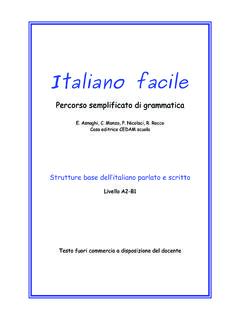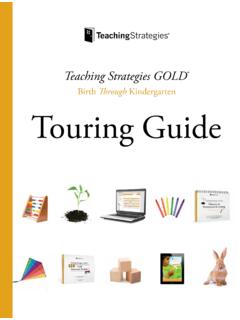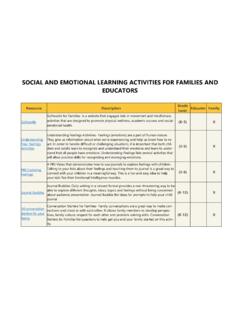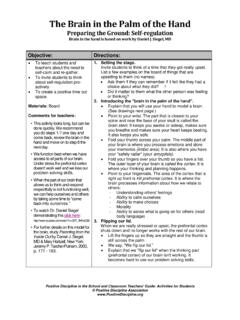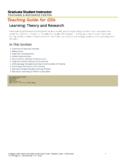Transcription of Understanding Psychology - iMater
1 Chapter Overview Visit the Understanding PsychologyWeb site at click on Chapter 12 Chapter Overviewsto preview the JournalThink about the present-dayconcerns and future aspirationsthat are most important to 6 to 10 of them in anyorder in your journal. Why did Davis play football so intensely? Why do people try toclimb Mount Everest or cross the Atlantic in a balloon? Whydo some people spend every waking moment memorizingbatting averages, while others do not know the difference between theNew York Yankees and the Toledo Mud Hens? As the song asks, why dofools fall in love?Theories of Motivation Main IdeaPsychologists explain motivation andwhy we experience it in different waysthrough instinct, drive-reduction, incentive, and cognitive theories ofmotivation. Vocabulary motivation instincts need drive homeostasis incentive extrinsic motivation intrinsic motivation Objectives Describe four theories of motivation.
2 Discuss the difference between intrin-sic and extrinsic s GuideExploring PsychologyDon t Look BackWillie Davis, the great defensive endat Green Bay.. had given [another player]a kind of mental tip that he used to moti-vate himself. He had used it ever since agame the Packers lost against the Eaglesback in the 1960s. As he left the field atthe end of the game, Davis had turnedaround, the stands emptying, and he real-ized that he was leaving something on thefield namely, regrets that he had notgiven the extra effort, the extra push ..and that he was going to have to live withthat regret for the rest of his life becausethere was no way that he could recapturethat moment. He made up his mind thenthat he would never again look back at afootball field or even a day s effort at whathe was doing with any sense of regret. from The X Factor: A Quest for ExcellencebyGeorge Plimpton, 1995 Chapter 12 / Motivation and Emotion313motivation: an internal statethat activates behavior anddirects it toward a goalAlthough all Psychology is concerned with what people do and howthey do it, research on motivation and emotion focuses on the underly-ing whys of behavior.
3 Motivationincludes the various psychological andphysiological factors that cause us to act a certain way at a certain see Kristin studying all weekend while the rest of us hang out, andsince we know she wants to go to law school, we conclude that she ismotivated by her desire to get good grades. We see Mikko working afterclasses at a job he does not like, and since we know he wants to buy acar, we conclude that he is motivated to earn money for the car. Moviesoften have motives or emotions as their central theme. On the street, youhear words like anger, fear, pain, starving,and hundreds of othersdescribing motives and emotions . Conceptions of motivation in psychol-ogy are in many ways similar to those expressed in everyday motivation cannot be observed directly, psychologists, like therest of us, infer motivation from goal-directed behavior. Human behavioris energized by many motives that may originate from outside of us orinside of explain motivation and why we experience it in differ-ent ways.
4 We will discuss instinct, drive-reduction, incentive, and cogni-tive theories of THEORYIn the 1900s, psychologist William McDougall (1908) proposed thathumans were motivated by a variety of instincts. Instinctsare natural orinherited tendencies of an organism to make a specific response to cer-tain environmental stimuli without involving reason. Instincts occur inalmost the same way among all members of a species. For example,salmon respond to instinctive urges to swim thousands of miles throughocean waters and up rivers to reach the exact spot in a gravel bed wherethey were spawned years earlier. Psychologist William James (1890) pro-posed that humans have instincts such as cleanliness, curiosity, parentallove, sociability, and , though, psychologists realized a flaw in the instinct do not explain behavior; they simply label behavior. Althoughsome psychologists still study instinctual behaviors (now called fixed actionpatterns), they have focused on other theories to explain THEORYS omething that motivates us moves us to action.
5 The thing that moti-vates us starts with a needthat leads to a drive. A need results from alack of something desirable or useful. We have both physiological andpsychological needs. We need oxygen and food to survive (physiologicalneeds). We may also need self-esteem or social approval (psychologicalneeds). We learn our psychological needs with practice; failing to fulfillsome of them is not life-threatening. 314 Chapter 12 / Motivation and Emotioninstincts:innate tendenciesthat determine behaviorneed: biological or psycho-logical requirement of an organismA need produces a drive. A driveis aninternal condition that can change over timeand orients an individual toward a specificgoal or goals. We have different drives withdifferent goals. For example, hunger drives usto eat, curiosity drives us to find somethingout, and fatigue drives us to theory emerged from thework of experimental psychologist Clark Hull(1943), who traced motivation back to basicphysiological needs.
6 According to Hull, whenan organism is deprived of something it needsor wants (such as food or water), it becomestense and agitated. To relieve this tension, itengages in more or less random activity. Thusbiological needs drivean organism to act, andthe organism strives to maintain the tendency of the body to return to or maintain a balanced a behavior reduces a drive, the organism will begin to acquire ahabit. That is, when the drive is again felt, the organism will tend first totry the same response. Habits channel drives in certain directions. In short,drive-reduction theory states that physiological needs drive an organismto act in either random or habitual ways. This drive continues until theorganism s needs are satisfied and it returns to a preset optimal suggested that all human motives from the desire to acquireproperty to striving for excellence and seeking affection or amusement are extensions of basic biological needs.
7 For example, people develop theneed for social approval because as infants they were fed and cared for bya smiling mother or father. Gradually, through conditioning and general-ization, the need for approval becomes important in itself. So, accordingto Hull, approval becomes a learned drive. The results of subsequent experiments suggested, however, that Hullhad overlooked some of the more important factors in human and ani-mal motivation. According to drive-reduction theory, infants becomeattached to their mothers because mothers usually relieve such drives ashunger and thirst. Harry Harlow (1905-1981) and others doubted thatthis was the only, or even the main, source of an infant s love for its moth-er. Harlow took baby monkeys away from their mothers and put themalone in cages with two surrogate, or substitute, mothers made mostly ofwire (see Figure ). One of the wire mothers was equipped with a bot-tle.
8 If the drive-reduction theory were correct, the monkeys wouldbecome attached to this figure because it was their only source of other wire mother was covered with soft cloth but could not providefood to relieve hunger. In test after test, the baby monkeys preferred tocling to the cloth mother, particularly when strange, frightening objectswere put into their cages (Harlow & Zimmerman, 1959).Some drive theorists overlooked the fact that some experiences (suchas hugging something or someone soft) are inherently : a state of tension pro-duced by a need that motivatesan organism toward a goalhomeostasis:the tendencyof all organisms to correctimbalances and deviations fromtheir normal stateChapter 12 / Motivation and Emotion315 Reading CheckWhat is the differencebetween a need and a drive?Harlow s Monkeys The monkeys inHarlow s study spentmost of their time withthe cloth mother eventhough they fed fromthe wire mother.
9 Whatdoes this result indicate about motivation?Figure motivation:engaging in activities that eitherreduce biological needs or helpus obtain external incentivesintrinsic motivation:engaging in activities becausethey are personally rewarding orbecause they fulfill our beliefsand expectationsincentive:an external stimu-lus, reinforcer, or reward thatmotivates behaviorAlthough these experiences do not seem to reduce bio-logical drives, they serve as incentives or goals forbehavior. Also, sometimes we engage in activities thatincrease the tension we experience. For example,although you do not need or want extra anxieties,you may enjoy riding roller coasters or watchingscary movies. These activities momentarily increaseyour anxiety and disrupt your homeostasis. Many psychologists conclude that there couldbe no general theory of motivation of the typeHull suggested. There are many types of behaviorthat cannot be explained through THEORYThe drive-reduction theory of motivationemphasizes the internal states of the organism;however, the incentive theory stresses the role ofthe environment in motivating behavior.
10 Whereas adrive is something inside of us that causes us to act,our actions are directed toward a goal, or incentive. Anincentiveis the object we seek or the result we are try-ing to achieve through our motivated behavior. Incentivesare also known as reinforcers, goals, and rewards. While drives push us to reduce needs, incentives pull us to obtainthem. For example, hunger may cause us to walk to the cafete-ria, but the incentive for our action is the sandwich we intend to our drive (hunger) is so strong that we do not care if theincentive (sandwich) is weak. For example, if we are really hungry, we mayeat a sandwich from the cafeteria even though we know that the cafeteria ssandwiches are not that tasty. However, if our drive (hunger) is weak, ourincentive must be strong. For instance, you may be slightly hungry but really like peanut butter sandwiches, so you will eat are motivated to obtain positive incentives and to avoid negative incentives.
